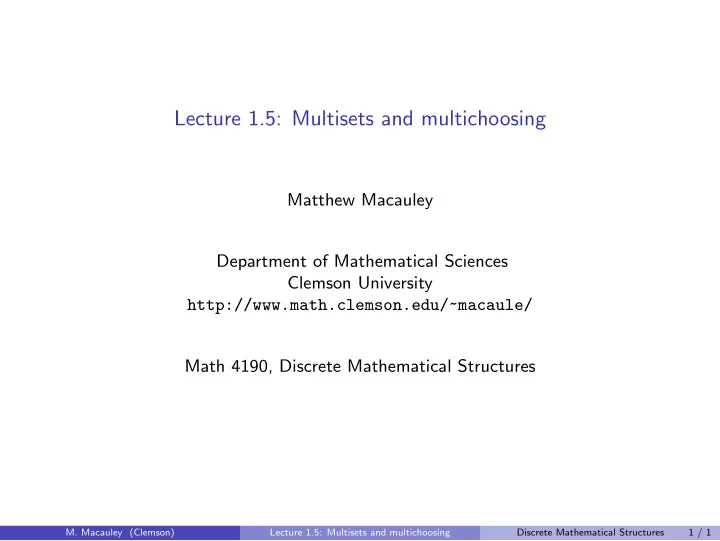

Lecture 1.5: Multisets and multichoosing Matthew Macauley Department of Mathematical Sciences Clemson University http://www.math.clemson.edu/~macaule/ Math 4190, Discrete Mathematical Structures M. Macauley (Clemson) Lecture 1.5: Multisets and multichoosing Discrete Mathematical Structures 1 / 1
Overview Consider an n -element set S . We can construct: lists from S (order matters) sets from S (order doesn’t matter). We can count: lists of length k : n ! n ( n − 1) · · · ( n − k + 1) = ( n − k )!, if no repetitions allowed n k , if repetitions are allowed. sets of size k : � � n ! n = k ! ( n − k )!, if no repetitions allowed k ??? if repetitions are allowed. In this lecture, we will answer this last part. A set with repetition is called a multiset. M. Macauley (Clemson) Lecture 1.5: Multisets and multichoosing Discrete Mathematical Structures 2 / 1
Notation Definition � n � � � Let be the number of k -element multisets on an n -element set. k We will write multisets as � . . . � , rather than { . . . } . Remark Unlike for combinations, k could be larger than n . Exercise Let S = { a , b , c , d } . (i) How many 2-element sets can be formed from S ? (ii) How many 2-element multisets can be formed from S ? Exercise (rephrased) Let S = { a , b , c , d } . (i) How many ways can we choose 2 elements from S ? (ii) How many ways can we multichoose 2 elements from S ? M. Macauley (Clemson) Lecture 1.5: Multisets and multichoosing Discrete Mathematical Structures 3 / 1
Counting multisets Proposition � � � � � � n n + k − 1 The number of k -element multisets on an n -element set is = . k k Proof We will encode every multiset using “ stars and bars notation .” � represents a “divider.” � Each * represents an element, and the M. Macauley (Clemson) Lecture 1.5: Multisets and multichoosing Discrete Mathematical Structures 4 / 1
Counting multisets Examples 1. You want to buy 3 hats and there are 5 colors: R, G, B, Y, O. How many possibilities are there? 2. You want to buy 5 hats and there are 3 colors: R, G, B, Y, O. How many possibilities are there? M. Macauley (Clemson) Lecture 1.5: Multisets and multichoosing Discrete Mathematical Structures 5 / 1
Counting multisets Examples 1. How many ways can you buy 6 sodas from a vending maching that has 8 flavors? 2. How many ways can you buy 7 sodas from a vending maching that has 7 flavors? M. Macauley (Clemson) Lecture 1.5: Multisets and multichoosing Discrete Mathematical Structures 6 / 1
A multiset identity Theorem � � � � � � � � n k − 1 For any n , k ≥ 1, we have = . k n − 1 Proof 1 (algebraic) � � � � � � � � � � � � n n + k − 1 n + k − 1 k + 1 Write = = = . � k k n − 1 n − 1 Proof 2 (combinatorial) Switch the roles of bars and stars. . . � M. Macauley (Clemson) Lecture 1.5: Multisets and multichoosing Discrete Mathematical Structures 7 / 1
Summary We can count various size- k collections of objects, from a “universe” of n objects. repetition allowed no repetition allowed n ! n k Ordered (lists) P ( n , k ) = ( n − k )! � � � � � � � � n + k − 1 n ! n n Unordered (sets, = C ( n , k ) = = k !( n − k )! k k k multisets) Different ways to think about multisets (everyone has their favorite) � n � � � The quantity counts: k the number of ways to put n identical balls into buckets B 1 , . . . , B n . the number of ways to distribute k candy bars to n people. the number of ways to buy k sodas from a vending machine with n varieties. the number of ways to choose k scoops of ice cream from n flavors. The number of nonnegative integer solutions to x 1 + x 2 + · · · + x n = k . The number of positive integer sequences a 1 , a 2 , . . . , a k where 1 ≤ a 1 ≤ a 2 ≤ · · · ≤ a k ≤ n . M. Macauley (Clemson) Lecture 1.5: Multisets and multichoosing Discrete Mathematical Structures 8 / 1
Combinatorial proofs: counting things different ways Sometimes, there are different ways to count the same set of objects. This can lead to two different formulas that are actually the same; a “ combinatorial identity .” Verifing an identity by counting a set two different ways is a combinatorial proof, the topic of the next lecture. But first, we’ll see an example of this involving multisets. M. Macauley (Clemson) Lecture 1.5: Multisets and multichoosing Discrete Mathematical Structures 9 / 1
Combinatorial proofs: counting things different ways Example You have 11 Biographies and 8 Mysteries that you want to arrange on your bookshelf, but no two mysteries can be adjacent to each other. How many different rearrangements are possible? M. Macauley (Clemson) Lecture 1.5: Multisets and multichoosing Discrete Mathematical Structures 10 / 1
Recommend
More recommend